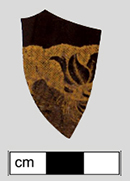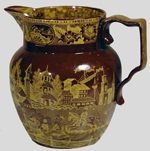Click on individual image to see larger view
Yellow Printed Brown Ware
Metzler's Hotel Site (36FU0070)
Harrisonville, Fulton County, Pennsylvania
This hotel was built in response to the 1817 completion of the Chambersburg-Bedford Turnpike,
and it appears that this context was buried by a mid-nineteenth century rear addition to the hotel.

This sherd, which appears to be from a jug or similar hollow
vessel, was found within a
mid-nineteenth century fill. The interior
of the vessel
was coated in white slip.
Photo courtesy of EAC/ Archaeology, Inc., Baltimore, Maryland.
Private Collection




style motif. The interior of the jug is coated
with a white slip. Jug height: 7 inches tall
style motif. 4¾ inches tall.
Chinoserie- style motif. 4½ inches tall.
(lid missing)